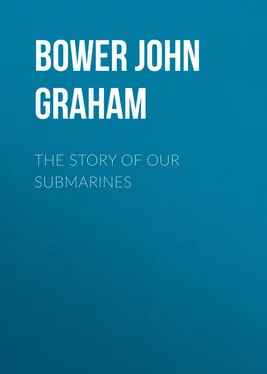John Bower - The Story of Our Submarines
Здесь есть возможность читать онлайн «John Bower - The Story of Our Submarines» — ознакомительный отрывок электронной книги совершенно бесплатно, а после прочтения отрывка купить полную версию. В некоторых случаях можно слушать аудио, скачать через торрент в формате fb2 и присутствует краткое содержание. Жанр: foreign_antique, foreign_prose, foreign_language, на английском языке. Описание произведения, (предисловие) а так же отзывы посетителей доступны на портале библиотеки ЛибКат.
- Название:The Story of Our Submarines
- Автор:
- Жанр:
- Год:неизвестен
- ISBN:нет данных
- Рейтинг книги:4 / 5. Голосов: 1
-
Избранное:Добавить в избранное
- Отзывы:
-
Ваша оценка:
- 80
- 1
- 2
- 3
- 4
- 5
The Story of Our Submarines: краткое содержание, описание и аннотация
Предлагаем к чтению аннотацию, описание, краткое содержание или предисловие (зависит от того, что написал сам автор книги «The Story of Our Submarines»). Если вы не нашли необходимую информацию о книге — напишите в комментариях, мы постараемся отыскать её.
The Story of Our Submarines — читать онлайн ознакомительный отрывок
Ниже представлен текст книги, разбитый по страницам. Система сохранения места последней прочитанной страницы, позволяет с удобством читать онлайн бесплатно книгу «The Story of Our Submarines», без необходимости каждый раз заново искать на чём Вы остановились. Поставьте закладку, и сможете в любой момент перейти на страницу, на которой закончили чтение.
Интервал:
Закладка:
By the nature of the German strategy our lines of design were indicated. The chief type we needed were scouts – in other words, patrol boats. We built these in considerable numbers, for the several types of patrol boats we diverged into were capable of doing any of several things. They could do the Heligoland Bight patrol, attacking the enemy if met with, and reporting to the C. – in-C. what they saw on their patrols; they could go out into the Atlantic to hunt U-boats on the traffic lanes, or they could go to the Mediterranean to work in the Adriatic. They were the general-utility craft of the Submarine Navy.
The mine-layers were of the patrol boat type, getting larger as the War went on, but always with the torpedo-tubes (reduced in number) built into them to allow them to become normal submarines when a chance arose.
In the early part of the War there were some additions to the Submarine Flotillas in the shape of V-W and F boats of 500 submerged tonnage. These were experiments by the Admiralty in building boats of foreign design, drawings being used of the Laurenti and Fiat firms. After these boats had been tried and their best points copied into our own designs, the standard British ideas were reverted to for war construction. The building of these boats served its purpose in giving us an insight into the lines upon which other nations were working, but foreign designs were not continued owing to the better performances of our own boats.
The G and J class were patrol boats – the G's being of 975 ton submerged displacement, and so larger and with more beam than the E boats; the J's were 19-knot boats of 1820 tons submerged, and marked a great advance in the big-submarine type. The year 1915 gave us the addition of a number of E class, while the G's began to join up with the Flotillas in November of that year. The first J boat commissioned in the spring of 1916.
The H class were small patrol boats of American design – a design later enlarged and improved in England. The L boats were enlarged and improved E's, and are probably the finest patrol submarines in existence.
The 4th August 1916 saw the commissioning of a boat which was a revolution in submarine design. This was the first K boat. This class was designed for the expected Fleet action; their qualities were to be – that they should have several knots in hand over the speed of the Battle Fleet, that they should be seaworthy and able to cruise with the Fleet, and that they should have the necessary submarine qualities to enable them to deal with the High Sea Fleet when it should be met. These qualities they have; but it is regretted that the enemy gave them no chance of trying their luck in action. They were used on patrol to keep them from getting stale during the long wait for their "Day," and their experiences on patrol, and when at sea on the periodic occasions when the Fleet went hurrying out in reply to reported enemy activity, have given invaluable data for future construction of large and fast submarines. These boats are of 1880 tons (surface) and 2550 tons (submerged) displacement. They have a speed of slightly over 24 knots on the surface, can carry a good gun battery if required, and their hulls being low and well stream-lined, and their torpedo armament powerful, they can act both as destroyers by night or as submarines by day.
These boats have a battery capacity sufficient for a day's Fleet battle, but no more. They may be described as having great strategic speed and capacity, but small tactical radius: that is, they can get to the place where they are wanted quickly, but are circumscribed in their capabilities of remaining submerged in that spot for long, or of moving fast submerged for more than one attack without rising to recharge their batteries. In submarine design as well as in that of surface ships, you can't have everything; each type is a compromise.
At the other end of the scale we built the R boat. These were also "specialists," but of opposite qualities. Of 500 tons (submerged) they have a surface speed of about 8 knots, but a submerged speed of 14½ – a speed which will probably be slightly increased by alterations. These boats only joined up in the summer of 1918, and the enemy surrendered before they had really shown what they could do. A boat of this type (they are perfectly stream-lined, and, inside, they are all battery and torpedo tubes) can jog out to her assigned area at her leisure – it is no use sending her to cut off or meet a definitely reported enemy, as she wouldn't get there in time – and once in that area she can use her diving batteries for days without having to recharge them, should she be kept down by enemy hunters, and her high submerged speed and radius make her very dangerous to any target (U-boat or otherwise) which passes within periscope range of her.
There remains the submarine monitor, which will be described in due course. I will interpolate here an account of a typical trial of a new boat, using an E boat of the early 1916 vintage as an illustration.
II
The boat I would use as an illustration was in 1915 very new indeed. She was just a standard E boat, with war-taught improvements and additions, and with a war-taught complement of officers and a half-taught complement of men. For a month the men had been given a queer but useful course of instruction by being taken by their First Lieutenant at "Diving Stations," in a disused shed in the building firm's premises. On the walls and floor names and rough sketches of most of the important valves and wheels of the boat herself had been chalked, and though the men laughed and swore at the make-believe, they had learnt a good deal of their drill and the probable sequence of diving orders, without the work of the builders of the E boat being interfered with. Except in the dinner hour, or during the infrequent holidays, no drill could be carried out aboard owing to the crowds of men working there. Overtime had been continuously worked, and nothing could be allowed to interfere with the firm's sacred "date" – the day on which the Admiralty had been promised delivery.
The day dawned clear and fine, with no wind and every promise of calm spring weather. At six o'clock the submarine's whistle blew shrilly, and a few tardy passengers approaching from the direction of the yard gates broke into a run. As they climbed the iron rungs up to the low grey-painted bridge, the gangway by which they had boarded was lifted clear into the air and swung away to the basin-side by a hissing, clattering, 10-ton crane, and at an order from the boat's Captain the securing wires and hemp hawsers splashed into the oily still water. The telegraph clanged decisively, and to an answering whirr and boil under her stern the boat moved slowly ahead towards the open basin entrance. She increased speed as she neared the narrow passage, and the whirling eddies of a flooding tide outside came in view. As her stem came out into the river she took a sharp sheer up-stream, then came quickly round towards the open sea as the twenty degrees of helm that she was carrying took effect on her. Little puffs of white and brown smoke began to show round her stern as the engines were clutched in and started, and in five minutes she was heading down-river at a fair twelve knots, with the low sun glancing from her round hull and lighting the queer mixture of Futurist painting that covered her.
Читать дальшеИнтервал:
Закладка:
Похожие книги на «The Story of Our Submarines»
Представляем Вашему вниманию похожие книги на «The Story of Our Submarines» списком для выбора. Мы отобрали схожую по названию и смыслу литературу в надежде предоставить читателям больше вариантов отыскать новые, интересные, ещё непрочитанные произведения.
Обсуждение, отзывы о книге «The Story of Our Submarines» и просто собственные мнения читателей. Оставьте ваши комментарии, напишите, что Вы думаете о произведении, его смысле или главных героях. Укажите что конкретно понравилось, а что нет, и почему Вы так считаете.












